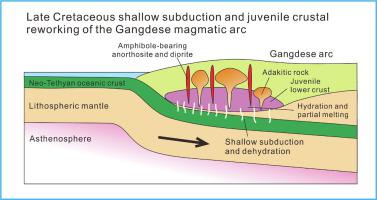Gondwana Research ( IF 7.2 ) Pub Date : 2021-07-24 , DOI: 10.1016/j.gr.2021.07.017 Huixia Ding 1 , Zeming Zhang 1, 2 , Matthew J. Kohn 3

|
The Gangdese arc in southern Tibet formed during subduction of the Neo-Tethyan ocean and is characterized by mantle-derived magma accretion and juvenile crustal growth. A main period of magmatism and juvenile crustal growth occurred during the Cretaceous, but little is known about the petrological component, nature, and evolution of the lower arc crust at that time. Here, we report systematic petrologic, geochemical and geochronologic data for amphibole-bearing anorthosite and diorite from the eastern Gangdese arc. The studied rocks occur within early Late Cretaceous gabbro or meta-gabbro, and consist mainly of plagioclase and amphibole with other hydrous phases, including minor muscovite, biotite and epidote. Zircon U–Pb dating gives Late Cretaceous crystallization ages of ca. 78 Ma. The rocks have varying SiO2 (47.44–57.35 wt.%), Al2O3 (19.76–25.15 wt.%), MgO (0.55–3.43 wt.%) and FeOT (0.89–8.31 wt.%) contents that can be explained as resulting from a primary melt with either plagioclase addition or amphibole accumulation. Trace element compositions show unusually high Sr/Y (59.3 to 948, average 278), but moderate (La/Yb)N (3.2 to 16.6, average 6.4). Isotopic compositions of Sr, Nd, and Hf (initial 87Sr/86Sr = 0.704186 – 0.704552, εNd(t) = +2.8 to +4.6 and zircon εHf(t) = +10.2 to +15.8) are comparable to the early Late Cretaceous gabbros that form the juvenile lower crust. These geochemical characteristics imply that the studied rocks were likely derived from hydrous anatexis of early Late Cretaceous juvenile lower crust. We suggest that shallow-angle subduction and dehydration of the Neo-Tethyan oceanic plate resulted in thickening and hydrous partial melting of juvenile lower crust to form water-rich anorthosite, diorite, and previously reported adakitic rocks during the Late Cretaceous. The juvenile lower crust of the Gangdese arc consisted of hydrous mafic granulites, and experienced distinct thickening and reworking during the Late Cretaceous.
中文翻译:

藏南冈底斯岩浆弧东部新生下地壳晚白垩世含水熔融与改造
藏南冈底斯弧形成于新特提斯洋俯冲过程中,以幔源岩浆增生和新生地壳生长为特征。白垩纪是岩浆活动和地壳幼年生长的主要时期,但当时对下弧地壳的岩石成分、性质和演化知之甚少。在这里,我们报告了来自冈底斯弧东部的含角闪石斜长岩和闪长岩的系统岩石学、地球化学和地质年代学数据。研究的岩石发生在晚白垩世早期辉长岩或变辉长岩内,主要由斜长石和角闪石组成,其他水相包括少量白云母、黑云母和绿帘石。锆石 U-Pb 测年给出了白垩纪晚期的结晶年龄大约为 78 马。岩石有不同的SiO 2(47.44–57.35 wt.%)、Al 2 O 3 (19.76–25.15 wt.%)、MgO (0.55–3.43 wt.%) 和 FeO T (0.89–8.31 wt.%) 的含量可以解释为由具有斜长石添加或角闪石积累的初级熔体。微量元素组成显示出异常高的 Sr/Y(59.3 至 948,平均 278),但中等 (La/Yb) N(3.2 至 16.6,平均 6.4)。Sr、Nd 和 Hf 的同位素组成(初始87 Sr/ 86Sr = 0.704186 – 0.704552、εNd(t) = +2.8 至 +4.6 和锆石 εHf(t) = +10.2 至 +15.8) 与形成幼年下地壳的晚白垩世早期辉长岩相当。这些地球化学特征表明,所研究的岩石可能来自晚白垩世早期幼年下地壳的含水贫矿。我们认为,新特提斯洋板块的浅角俯冲和脱水导致幼年下地壳增厚和含水部分熔融,形成富水斜长岩、闪长岩和早先报道的晚白垩世埃达克质岩石。冈底斯弧的幼年下地壳由含水镁铁质麻粒岩组成,在晚白垩世经历了明显的增厚和改造。











































 京公网安备 11010802027423号
京公网安备 11010802027423号